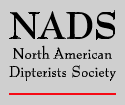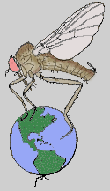
.jpg)
Home | General | "Empididae" | Dolichopodidae | CNC Types | Dolichopodidae Checklist | Dolichopodidae Higher Classification
Empidoidea Higher Classification
Characteristics and Natural History of “Empididae”
Higher classification and diversity
The Empidoidea are considered to be a monophyletic lineage that is the sister group to the Cyclorrhapha (Cumming et al. 1995; Cumming and Sinclair 1996; Collins and Wiegmann 2002). Traditionally the superfamily has been divided into two families, the paraphyletic “Empididae” and the monophyletic Dolichopodidae. Chvála (1983) was the first to divide the Empidoidea into several families, namely the Empididae, Hybotidae, Atelestidae, Microphoridae, and Dolichopodidae, but recognition of the precise limits of these families, particularly on a worldwide level, has remained debated (see Woodley 1989; Cumming 1989; Cumming et al. 1995). Recently an extensive cladistic analysis of the Empidoidea and the basal lineages of the Cyclorrhapha by Sinclair and Cumming (2006) resulted in these authors dividing the superfamily into following five families: Empididae, Hybotidae, Atelestidae, Brachystomatidae and Dolichopodidae s.lat. (see Empidoidea Higher Classification). However, for simplicity and the purpose of this web resource the “Empididae” are treated here in the more traditional sense to include all Empidoidea exclusive of Dolichopodidae s.str.
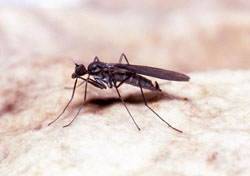 |
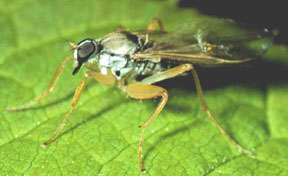 |
| Clinocera fuscipennis
Loew (photo by S.A. Marshall) |
Platypalpus holosericus
Melander |
The family “Empididae” in the traditional sense, is a diverse group of flies consisting of over 4,000 described species worldwide and about 800 described species in America north of Mexico. Numerous species remain to be described and it is estimated that the total diversity of the group will exceed 7,500 species worldwide. For North America, keys to the genera of “Empididae” can be found in Steyskal and Knutson (1981) and Cumming and Sinclair (in press). “Empidid” flies are not very well known at the species level for the Nearctic Region, because only a few genera have been recently revised (e.g. Cumming and Cooper 1992; Sinclair 1994; Sinclair 1997; MacDonald 1998) and few keys are available to distinguish species. Consequently, many species identifications depend on comparisons by specialists, of unidentified specimens with previously identified museum specimens.
Diagnosis and recognition
Adult “empidids” are small to medium sized flies that range in size from 1 to 15 mm. They are darkish to light in color, and are rarely metallic green. The head is variously shaped and usually narrower than thorax. The compound eyes are usually large and generally males are holoptic and females are dichoptic, but there are exceptions (e.g. females are holoptic in Hybotinae, males are dichoptic in many non-swarming groups as well as some swarming groups such as Hilara Meigen). The antenna has a one-segmented, variously shaped first flagellomere (postpedicel); a pedicel usually without a thumb-like conus inserted into first flagellomere; a stylus that is short to elongate and usually two-segmented, situated apically, or when situated more dorsally appearing arista-like. The proboscis is short to elongate; the labrum is usually armed at apex with epipharyngeal blades; the palpus is one-segmented. The chaetotaxy of head is generally limited, with a pair of ocellar bristles usually present, and vertical bristles present or absent. The thorax is usually rectangular in dorsal outline, sometimes extended anteriorly, with the disk of the thorax nearly flat to greatly arched and dome-like. The chaetotaxy of the thorax is often limited to notopleurals and scutellars, with various other dorsal bristles present. The wings are of varied shape and size, sometimes broadened, rarely reduced, with the alula and anal lobe often lacking; the wing colour is hyaline to infuscate and sometimes patterned. The wing venation is exceedingly varied, relatively complete to markedly reduced, with the anal cell (cup) closed and never reaching the wing margin. The legs are varied in length, thickness and armature; sometimes sexually dimorphic, with rows of pinnate bristles in females and clasping or glandular structures in males; often one pair bears raptorial modifications; the empodium is usually setiform, but is pulvilliform in some aquatic groups. The abdomen is subcylindrical, usually elongate, sometimes short; some tergites possess abdominal plaques laterally. The male terminalia is either unrotated, twisted 45º to 90º to the right, or rotated 90º to 180º to the right and lateroflexed; often the genitalia are asymmetric; the ejaculatory apodeme is lever-like and articulated ventrally against base of phallus (see Cumming et al. 1995; Sinclair 2000). The female terminalia are with or without acanthophorites, and there is one spermatheca internally.
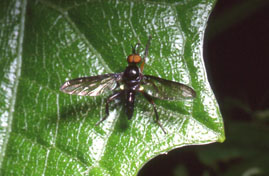 |
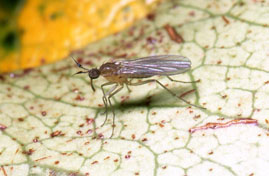 |
| Empis sp. (photo by S.A. Marshall) |
Ceratomerus
sp. |
“Empidids” can generally be differentiated from the similar Dolichopodidae s. str. by their lack of green metallic body coloration. However, some “Empididae” (e.g. most Lamprempis Wheeler and Melander) are metallic green and some dolichopodids are not metallic. However, all Dolichopodidae have the Rs vein originating at or near the level of crossvein h and have crossvein r-m situated in the basal fourth of the wing unlike “empidids” (except the microphorid genera), which have the Rs vein originating well distal to the level of crossvein h and have crossvein r-m distal to the basal fourth of the wing. In addition, male dolichopodids have their terminalia rotated forward beneath the preceding segments of the abdomen, unlike empidids (except the microphorid genera). The microphorid group of genera (sensu Chvála 1983) are similar to dolichopodids, but they are never metallic green and have cell dm closed by a complete or nearly complete bm-cu crossvein, rather than having cells dm and bm confluent. Some bombyliid and asiloid groups (e.g. therevids s.l.) can be confused with “empidids”, but these flies generally have a larger anal cell (cup) that attains, or nearly attains, the wing margin and they lack predacious modifications in either the legs or the mouthparts. A few platypezids (e.g. Microsania Zetterstedt) can also be confused with empidids, but the arista of these small flies is three-segmented rather than two-segmented (as in the stylus of most “empidids”), and the acrostichal setae are uniserial, rather than biserial or absent. Immature stages are known for only a few species of “Empididae” (see Steyskal and Knutson 1981; Cumming and Cooper 1993) and these are very similar in general to the immature stages of Dolichopodidae s.str.
Natural history
The species classified in the “Empididae” represent a large group of predaceous flies, including a few flower-visiting taxa. Adults are often found in various forest habitats, on leaves, tree trunks, aquatic vegetation, or in stream beds and seepage habitats, although some taxa are associated with more open areas such as agricultural fields, grasslands, marshes, coastal zones and beaches (Collin 1961; Cumming and Cooper 1992). Adults capture various arthropod prey, including small to medium sized Diptera, Homoptera, Hemiptera, Thysanoptera, Lepidoptera, Trichoptera, Hymenoptera, Neuroptera, Ephemeroptera, Plecoptera, Coleoptera, Collembola, and Acari (Tuomikoski 1952; Smith 1969; Cumming and Cooper 1993). Predaceous “empidid” flies are important natural and biological control agents of various pest insect species because of the wide range of habitats occupied and their vast species diversity. A number of adult “Empididae” also visit flowers presumably to obtain nectar, but at least a few groups (e.g. Iteaphila Zetterstedt, Anthepiscopus Becker, Anthalia Zetterstedt, Allanthalia Melander and Euthyneura Macquart) obtain all their protein requirements by feeding on pollen (Downes and Smith 1969; Grimaldi 1999). Larvae are generally found in moist soil, rotten wood, dung, or in aquatic habitats and also appear to be predaceous on various arthropods, particularly other Diptera larvae (Cumming and Cooper 1993).
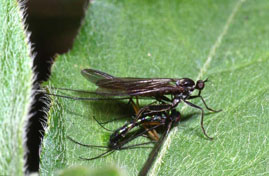 |
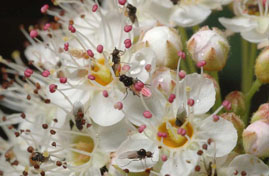 |
| Aplomera sp. with dolichopodid
prey (photo by S.A. Marshall) |
Anthalia
sp. |
Many species of “Empididae” mate on the ground or on vegetation while others gather in mating swarms (Downes 1969; Chvála 1976, 1983). The synchronized movement of adult flies within these mating swarms is the basis for the common name “dance flies” which is sometimes used for the family. Members of one large subfamily, the Empidinae, transfer nuptial gifts from male to female during courtship and mating (Cumming 1994). Depending on the species, these nuptial gifts include prey, various types of inedible objects, or secreted balloons. Within the Empidinae mate choice is generally by females that visit male-dominated swarms. However, many species exhibit sex-role reversed courtship behaviour where females gather in swarms to await males that choose mates. These species exhibit many female secondary sexual characters used in courting males, such as enlarged wings, pinnate leg scales, and eversible abdominal pleural sacs (Cumming 1994).
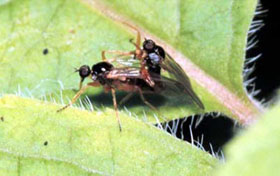 |
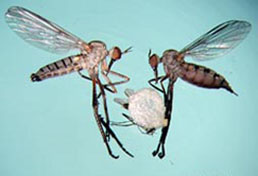 |
| Platypalpus sp. nr bicornis
Melander (photo by S.A. Marshall) |
Empis aerobatica
Melander |
References
Chvála, M. 1976. Swarming, mating and feeding habits in Empididae (Diptera), and their significance in evolution of the family. Acta Entomologica Bohemoslovaca 73: 353–366.
Chvála, M. 1983. The Empidoidea (Diptera) of Fennoscandia and Denmark. II. General Part. The families Hybotidae, Atelestidae and Microphoridae. Fauna Entomologica Scandinavica 12:1–279.
Collin, J.E. 1961. Empididae. British Flies, Volume 6. University Press, Cambridge, 782 pp.
Collins, K.P. and Wiegmann, B.M. 2002. Phylogenetic relationships and placement of the Empidoidea (Diptera: Brachycera) based on 28S rDNA and EF–1alpha sequences. Insect Systematics and Evolution 33: 421–444.
Cumming, J.M. 1989. Book review of Chvála, M. 1983. The Empidoidea (Diptera) of Fennoscandia and Denmark. II. General Part. The families Hybotidae, Atelestidae, and Microphoridae. Fauna Entomologica Scandinavica, Volume 12. The Canadian Field-Naturalist 103: 620.
Cumming, J.M. 1994. Sexual selection and the evolution of dance fly mating systems (Diptera: Empididae; Empidinae). The Canadian Entomologist 126: 907–920.
Cumming, J.M. and Cooper, B.E. 1992. A revision of the Nearctic species of the tachydromiine fly genus Stilpon Loew (Diptera: Empidoidea). The Canadian Entomologist 124: 951–998.
Cumming, J.M. and Cooper, B.E. 1993. Techniques for obtaining adult-associated immature stages of predacious tachydromiine flies (Diptera: Empidoidea), with implications for rearing and biocontrol. Entomological News 104: 93–101.
Cumming, J.M. and Sinclair, B.J. 1996. The higher–level phylogeny of Eremoneura (Diptera: Brachycera). XX International Congress of Entomology, Proceedings. Florence, Italy, p. 24.
Cumming, J.M. and Sinclair, B.J. (in press) Family Empididae. In Brown, B.V., Borkent, A., Wood, D.M. and Zumbado, M. (eds.), Manual of Central American Diptera.
Cumming, J.M., Sinclair B.J. and Wood, D.M. 1995. Homology and phylogenetic implications of male genitalia in Diptera – Eremoneura. Entomologica Scandinavica 26: 121–151.
Downes, J.A. 1969. The swarming and mating flight of Diptera. Annual Review of Entomology 14: 271–298.
Downes, J.A. and Smith, S.M. 1969. New or little known feeding habits in Empididae (Diptera). The Canadian Entomologist 101: 404–408.
Grimaldi, D. 1999. The co-radiations of pollinating insects and angiosperms in the Cretaceous. Annals of the Missouri Botanical Garden 86: 373–406.
MacDonald, J.F. 1998. Review of the genus Hemerodromia Meigen (Diptera: Empididae; Hemerodromiinae) of America north of Mexico. Proceedings of the Entomological Society of Washington 100: 792–823.
Sinclair, B.J. 1994. Revision of the Nearctic species of Trichoclinocera Collin (Diptera: Empididae; Clinocerinae). The Canadian Entomologist 126: 1007–1059.
Sinclair, B.J. 1997. Review of the Nearctic species of Wiedemannia Zetterstedt (Diptera: Empididae: Clinocerinae). Studia dipterologica 4: 337–352.
Sinclair, B.J. 2000. Chapter 1.2. Morphology and terminology of Diptera male terminalia. Pp. 53-74 in Papp, L. and Darvas, B. (eds.), Contributions to a Manual of Palaearctic Diptera, Volume 1. General and Applied Dipterology. Science Herald, Budapest, pp. 1–978.
Sinclair, B.J. and Cumming, J.M. 2006. The morphology, higher-level phylogeny and classification of the Empidoidea. Zootaxa 1180: 1-172. PDF document
Smith, K.G.V. 1969. The Empididae of southern Africa (Diptera). Annals of the Natal Museum 19: 1–342.
Steyskal, G.C and Knutson, L.V. 1981. Chapter 47. Empididae. Pp. 607-624 in McAlpine, J.F., et al. (eds.), Manual of Nearctic Diptera. Volume 1. Agriculture Canada Monograph 27: vi + 1-674.
Tuomikoski, R. 1952. Über die Nahrung der Empididen–Imagines (Dipt.) in Finnland. Annales Entomologici Fennici 18: 170–181.
Woodley, N.E. 1989. Chapter 115. Phylogeny and classification of the “Orthorrhaphous” Brachycera. Pp. 1371–1395 in McAlpine, J.F. (ed.), Manual of Nearctic Diptera, Volume 3. Agriculture Canada Monograph 32: vi + 1333–1581.
First published on the Internet on 18 November 2005
Last update: 26 May, 2006
J.M. Cumming
